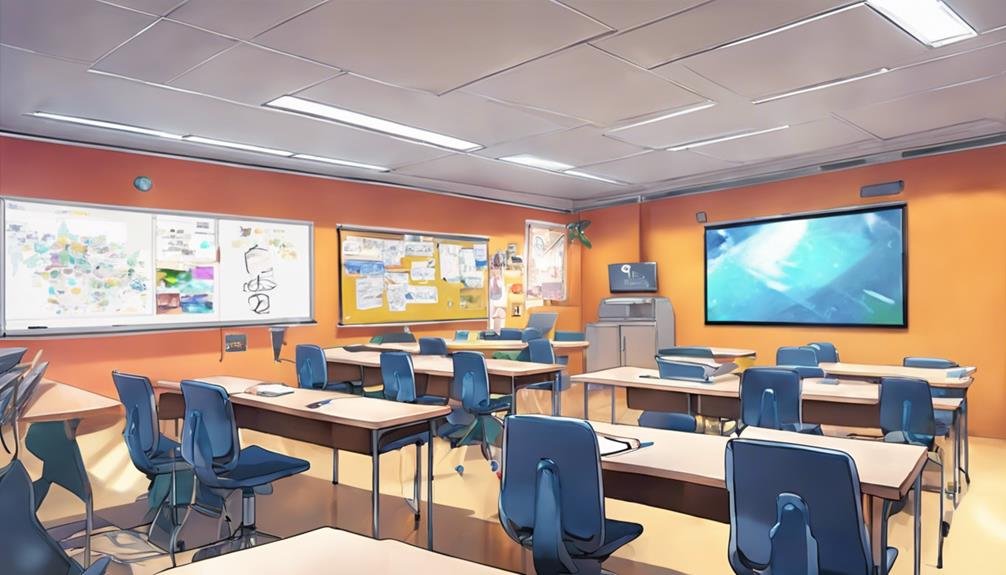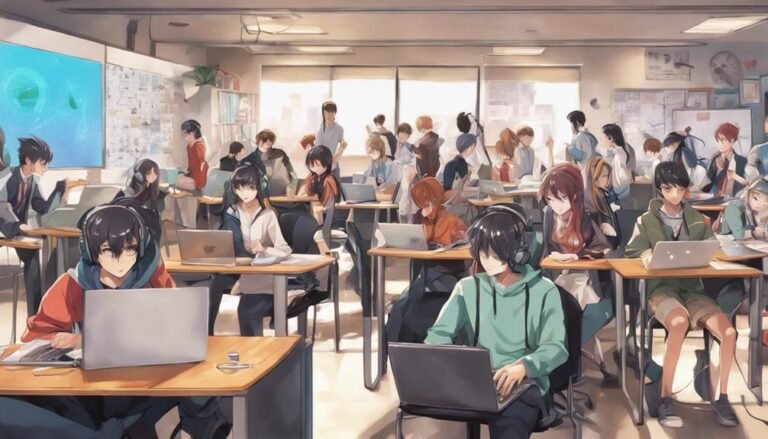How Do I Design Effective Virtual Classrooms for Synchronous Learning?
To design effective virtual classrooms for synchronous learning, prioritize user-friendly technology tools that align with your layout. Utilize interactive features like whiteboards and chat for engagement. Incorporate real-time quizzes and breakout rooms to boost participation. Design interactive activities that encourage critical thinking and storytelling. Implement gamification to enhance interactions. Foster collaboration through group projects and teamwork exercises. Use polls for engagement and tailor instruction based on metrics. Implement clear guidelines and behavior strategies for effective virtual classroom management. By combining these elements, you can create an engaging online learning environment that maximizes student participation and comprehension. Enhance your virtual classroom experience with these key strategies!
Key Takeaways
- Prioritize interactive tools for engagement.
- Design activities for collaboration and creativity.
- Use polls and quizzes for assessment and feedback.
- Implement breakout rooms for teamwork.
- Create a dynamic and engaging virtual environment.
Technology Tools Selection
When selecting technology tools for your virtual classroom, prioritize functionality and user-friendliness to enhance the learning experience. Consider how the tools can align with your classroom layout to create an engaging and interactive environment for your students. Utilizing engagement tools such as interactive whiteboards, polling software, and chat features can foster collaboration and participation among your virtual learners.
The classroom layout plays an essential role in how technology tools are utilized. Make sure that the tools you choose complement the virtual space and make navigation intuitive for both you and your students. For instance, placing the whiteboard tool in a central location can draw attention to important information and encourage active participation.
Incorporating engagement tools like real-time quizzes or breakout rooms can break up the monotony of online learning, keeping your students focused and motivated. These tools not only enhance the learning experience but also promote a sense of community within your virtual classroom. By carefully selecting technology tools that enhance your classroom layout and promote engagement, you can create a dynamic and effective virtual learning environment.
Interactive Activity Design
To create engaging and interactive virtual classrooms, focus on designing interactive activities that promote active participation and collaboration among your students. Incorporating role-playing scenarios can be an effective way to immerse your students in real-world situations, encouraging them to think critically and apply their knowledge in a practical context. By assigning roles and scenarios that challenge students to solve problems or make decisions, you can enhance their communication skills and foster a sense of teamwork within the virtual classroom.
Storytelling exercises are another powerful tool to engage students in the learning process. Encourage students to create and share stories related to the subject matter, allowing them to express their creativity and connect personally with the material. This not only makes learning more enjoyable but also helps students retain information better through meaningful narratives.
Engagement Strategies
Ready to boost engagement in your virtual classroom?
Interactive polls can energize discussions, while breakout rooms foster collaboration among participants.
Don't forget to sprinkle in some gamification elements to keep everyone actively participating!
Interactive Polls for Engagement
Enhance learner engagement through the use of interactive polls during virtual classroom sessions. By incorporating participation incentives and providing real-time feedback, you can create an interactive learning environment that keeps learners actively involved.
Interactive polls not only encourage engagement but also allow for immediate assessment of understanding. Through these polls, you can initiate interactive discussions based on responses, fostering a collaborative learning atmosphere.
Additionally, you can utilize engagement metrics from the polls to tailor your teaching approach to better suit the needs and preferences of your audience. These polls serve as a valuable tool for gauging comprehension, sparking discussions, and maintaining a dynamic virtual classroom that promotes active participation and knowledge retention.
Breakout Rooms for Collaboration
Breakout rooms in virtual classrooms foster collaboration among learners, encouraging active participation and dynamic interaction. Utilize this feature for group projects and teamwork exercises to enhance engagement.
Divide participants into smaller teams to work on specific tasks or discussions, promoting deeper involvement and shared responsibility. Encourage learners to exchange ideas, solve problems collectively, and build on each other's strengths. Assign roles within the groups to distribute tasks evenly and guarantee everyone contributes.
Monitor the breakout rooms to provide guidance and support where needed, keeping learners on track and fostering a sense of accountability. By incorporating breakout rooms strategically, you can create an interactive and collaborative learning environment that maximizes participation and teamwork.
Gamification for Participation
To boost learner engagement and foster active participation in virtual classrooms, consider implementing gamification strategies that incentivize interaction and collaboration. Incorporating a reward system and engagement techniques can greatly enhance the overall learning experience.
Introducing competition dynamics within the virtual classroom setting can spark motivation and drive participants to actively engage with the material. By leveraging motivation strategies such as points, badges, or leaderboards, you can create a more dynamic and interactive learning environment that encourages students to participate more actively.
Collaboration Techniques
Implementing effective collaboration techniques in virtual classrooms creates a dynamic and engaging learning environment for all participants.
When it comes to brainstorming techniques, encourage active participation by using digital whiteboards or chat features for real-time idea sharing.
Group projects can be facilitated through breakout rooms, allowing students to collaborate closely in smaller teams.
To enhance engagement, consider incorporating interactive tools like collaborative documents or project management platforms where students can work together seamlessly.
Encourage peer-to-peer interaction by assigning roles within groups, fostering a sense of responsibility and accountability.
Utilize synchronous communication channels for instant feedback and discussions, promoting active engagement and a sense of community.
By integrating these collaboration techniques, virtual classrooms can transform into vibrant spaces where students feel connected and motivated to participate actively in their learning journey.
Assessment Methods
Let's amp up your virtual classroom with dynamic assessment methods. Utilize quizzes to gauge understanding and interactive polls to keep learners engaged.
These tools won't only assess progress but also foster active participation in your synchronous learning environment.
Quiz for Understanding
Consider incorporating quizzes as a dynamic tool to assess understanding and enhance engagement in virtual classrooms. Quizzes provide valuable insights into student comprehension and help tailor teaching methods effectively. By analyzing quiz performance, educators can gauge learning outcomes and adjust their strategies accordingly.
Moreover, quizzes offer immediate feedback to students, enabling them to identify areas for improvement promptly. Incorporating a variety of question types, such as multiple-choice, true/false, and short answer, can cater to diverse learning styles. This approach not only fosters active participation but also encourages critical thinking and retention.
Leveraging quiz data for analysis allows instructors to make informed decisions to optimize the learning experience for all participants.
Interactive Polls for Engagement
Enhancing virtual classroom engagement through interactive polls fosters active participation and real-time feedback, enriching the learning experience for all participants.
By incorporating interactive polls into your synchronous sessions, you can gather real-time feedback, assess understanding, and track participation effectively. These polls provide valuable insights into the engagement levels of your learners, allowing you to adjust your teaching approach on the spot.
Through poll analysis, you can identify areas where students may be struggling or excelling, enabling you to tailor your instruction accordingly. Additionally, engagement metrics derived from these polls help you gauge the overall participation and interest levels, ensuring that your virtual classroom remains dynamic and interactive.
Utilize interactive polls to create a more engaging and interactive virtual learning environment.
Virtual Classroom Management
To effectively manage a virtual classroom, it's essential to establish clear guidelines and expectations for student behavior and participation. Implementing strategies for behavior management and promoting virtual etiquette can create a conducive learning environment.
Here are some key points to bear in mind:
- Establish Ground Rules: Clearly outline expectations regarding participation, communication, and respectful behavior in the virtual classroom.
- Encourage Student Engagement: Use interactive tools like polls, breakout rooms, or collaborative projects to keep students actively involved during the session.
- Provide Feedback and Support: Offer constructive feedback to students on their participation and progress to motivate them to stay engaged throughout the virtual classroom experience.
Conclusion
To sum up, designing effective virtual classrooms for synchronous learning is like painting a masterpiece on a digital canvas.
By carefully selecting technology tools, designing interactive activities, engaging students with creative strategies, fostering collaboration, implementing effective assessment methods, and managing the virtual classroom environment, you can create a vibrant and dynamic learning experience that captivates your audience and leaves a lasting impression.
Embrace the virtual classroom as your artistic palette and watch your students' knowledge and skills come to life.







